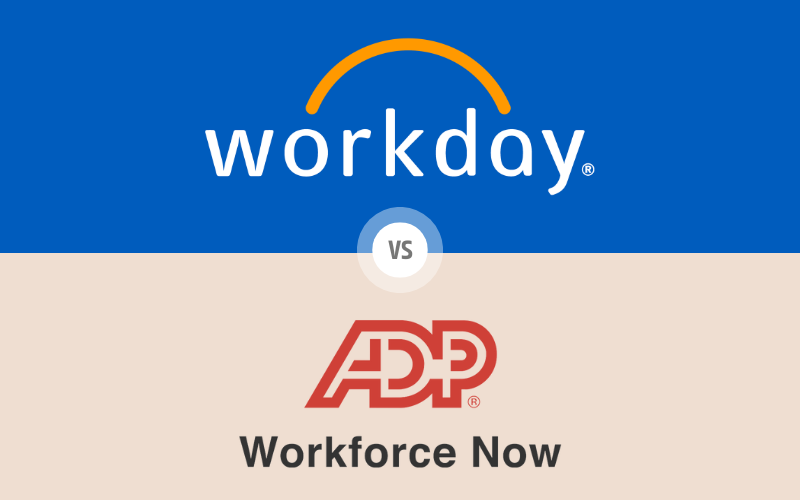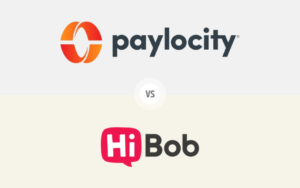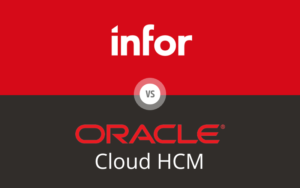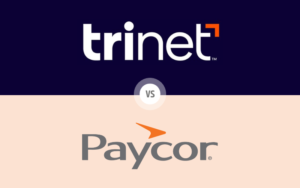In this comprehensive comparison of Workday vs ADP Workforce Now, we explore the strengths and features of two leading HCM platforms. Choosing the right Human Capital Management (HCM) system is crucial for optimizing your organization’s HR processes. Both Workday and ADP offer robust solutions designed to meet diverse business needs, but their approaches and capabilities differ significantly. This blog post will help you understand the key differences between Workday and ADP across various HR functions, providing the insights you need to make an informed decision for your organization.
Table of Contents
User Interface and User Experience
When comparing Workday vs ADP Workforce Now, the user interface (UI) and user experience (UX) are crucial factors to consider. Both platforms are designed to streamline HR processes, but they have distinct approaches to UI and UX.

Workday User Interface and User Experience
Workday boasts a modern, visually appealing interface that prioritizes user-friendliness. Its dashboard is clean and intuitive, making it easy for users to navigate through various features without extensive training. The layout is customizable, allowing HR teams to tailor the interface to suit their specific needs.
Key Features of Workday UI/UX:
- Customization: Users can personalize the dashboard with widgets and shortcuts to frequently used functions, enhancing efficiency.
- Visual Design: The interface uses vibrant colors and engaging visuals, creating a pleasant and engaging experience for users.
- Ease of Use: The platform is designed to be intuitive, reducing the learning curve for new users and minimizing the need for extensive training.
- Mobile Accessibility: Workday’s mobile app offers nearly the same functionality as the desktop version, making it convenient for users to access the system on the go.
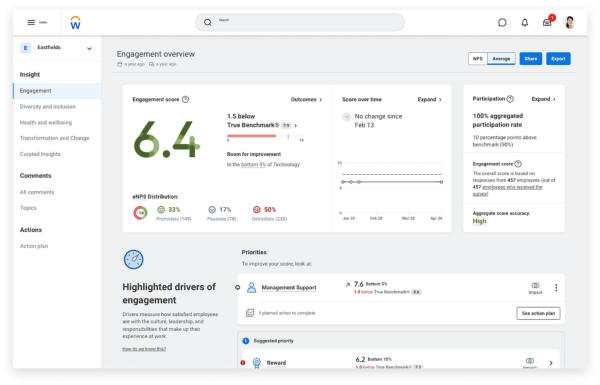
ADP Workforce Now User Interface and User Experience
ADP Workforce Now, while also user-friendly, adopts a more traditional approach compared to Workday. Its interface is designed to be comprehensive and functional, catering to the needs of larger organizations with complex HR requirements. The platform offers robust functionality, but it may require more time to master due to its extensive feature set.
Key Features of ADP Workforce Now UI/UX:
- Functionality: The platform provides a wealth of features and options, making it suitable for detailed HR management tasks.
- Navigation: While comprehensive, the interface is logically organized, helping users find the necessary tools and information.
- Professional Design: The design is professional and straightforward, focusing on functionality over aesthetics.
- Training Resources: ADP provides extensive training resources and customer support to help users overcome initial usability challenges.
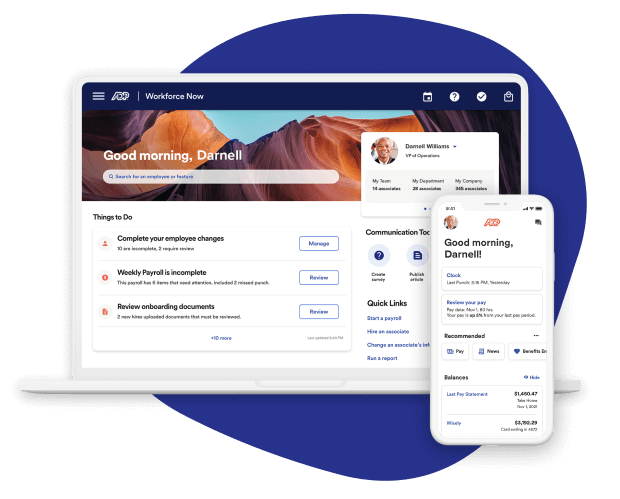
Comparison and Conclusion
In the debate of Workday vs ADP Workforce Now, the choice of user interface and user experience will largely depend on the specific needs of your organization. Workday excels in providing a modern, visually appealing, and highly customizable experience, making it ideal for organizations looking for simplicity and ease of use. On the other hand, ADP offers a more traditional, feature-rich interface that, while potentially more complex, is suited for larger organizations requiring comprehensive HR functionality.
Choosing between Workday and ADP Workforce Now will depend on whether your priority is a modern, user-friendly design or a comprehensive, functionality-driven interface. By evaluating these aspects in the context of your organization’s needs, you can make an informed decision that enhances user satisfaction and productivity.
Core HR Functions
When evaluating HCM software, core HR functions are a critical aspect to consider. Both Workday and ADP Workforce Now offer comprehensive core HR functionalities designed to streamline HR processes. Let’s examine how each platform performs in this essential area.

Workday Core HR Functions
Workday provides a robust suite of core HR functions that are designed to simplify and automate HR processes. Its integrated system ensures that all HR data is consolidated and easily accessible, which enhances decision-making and operational efficiency.
Key Features of Workday Core HR Functions:
- Employee Data Management: Workday allows for detailed employee records management, including personal information, job history, and skills.
- Onboarding: The platform offers a seamless onboarding process with automated workflows to ensure new hires are integrated smoothly.
- Time Tracking: Workday includes built-in time tracking tools, making it easy to monitor employee hours and attendance.
- Absence Management: The system provides robust absence management features, allowing HR to track and manage employee leave efficiently.
- Compensation Management: Workday’s compensation management tools help streamline salary planning, bonuses, and incentive programs.
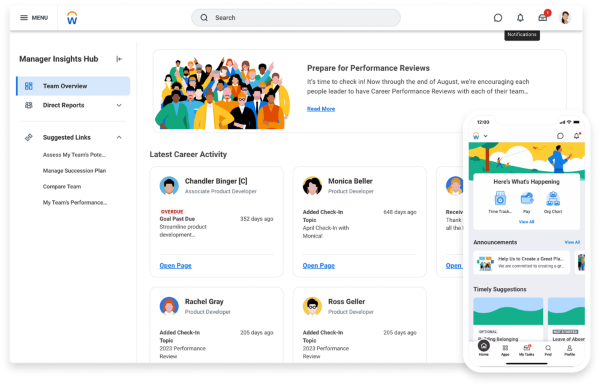
ADP Workforce Now Core HR Functions
ADP Workforce Now is well-known for its extensive core HR functions, catering to the needs of both small and large organizations. The platform offers a comprehensive set of tools to manage HR tasks efficiently.
Key Features of ADP Workforce Now Core HR Functions:
- Employee Records: ADP provides detailed employee record management, ensuring all personal and professional information is up-to-date and easily accessible.
- Onboarding: ADP’s onboarding features streamline the process, helping new employees get up to speed quickly with automated workflows.
- Time and Attendance: ADP offers robust time and attendance tracking, with various methods to capture employee hours, including mobile and biometric options.
- Leave Management: The platform includes comprehensive leave management features, making it easy to track and approve employee leave.
- Compensation and Benefits: ADP’s tools for managing compensation and benefits are extensive, covering everything from payroll processing to benefits administration.
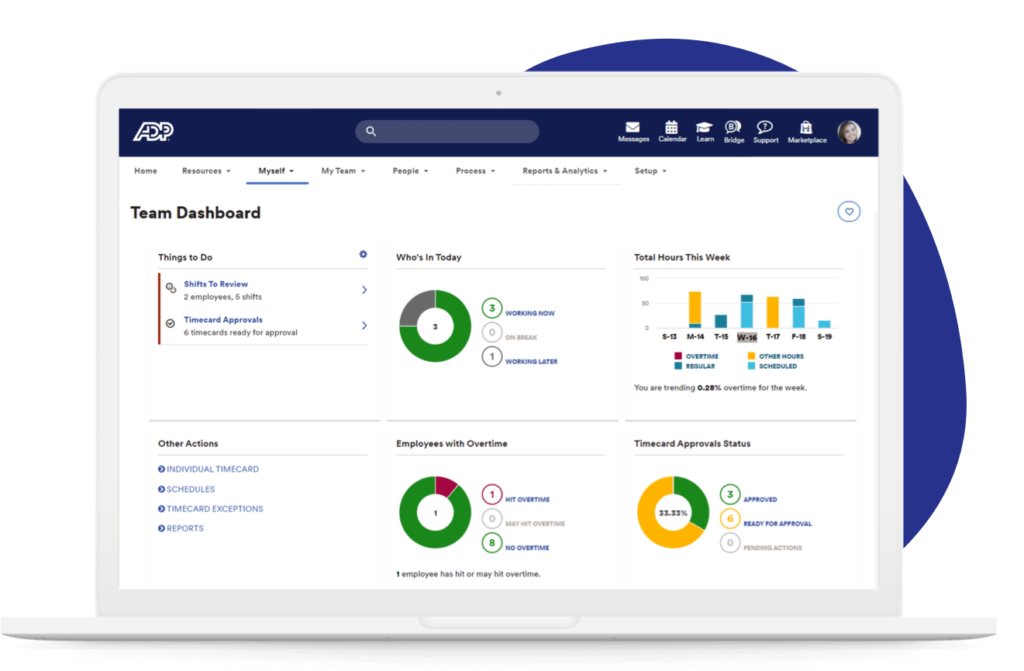
Comparison and Conclusion
In the debate of Workday vs ADP Workforce Now for core HR functions, both platforms offer powerful tools to manage essential HR tasks effectively.
Workday excels with its integrated and intuitive system, making it ideal for organizations seeking a modern, seamless experience. Its strong focus on automation and employee data management ensures that HR processes are efficient and accurate.
ADP Workforce Now, on the other hand, provides a comprehensive set of core HR functionalities with a focus on flexibility and reliability. Its extensive features for time tracking, leave management, and compensation make it a strong contender for organizations of all sizes.
Ultimately, the choice between Workday and ADP Workforce Now for core HR functions will depend on your organization’s specific needs and priorities. If you value a modern, integrated system with a focus on automation, Workday may be the better choice. If you require a flexible, feature-rich platform with extensive capabilities, ADP Workforce Now could be the right fit.
Payroll Management
Payroll management is a crucial function for any organization, ensuring employees are paid accurately and on time. Both Workday and ADP Workforce Now offer comprehensive payroll management solutions, but they approach this essential task differently. Let’s explore how each platform handles payroll management.

Workday Payroll Management
Workday provides a modern and integrated payroll management solution designed to streamline payroll processes and improve accuracy. Its cloud-based system ensures real-time data access and updates, enhancing efficiency and compliance.
Key Features of Workday Payroll Management:
- Integrated System: Workday’s payroll system is fully integrated with its core HR and time tracking modules, ensuring seamless data flow and reducing errors.
- Real-Time Calculations: The platform offers real-time payroll calculations, allowing HR teams to view and adjust payroll data instantly.
- Global Payroll Capabilities: Workday supports payroll management across multiple countries, making it ideal for global organizations.
- Compliance Management: The system includes built-in compliance features to help organizations adhere to local, state, and federal regulations.
- Employee Self-Service: Employees can access their payroll information, update details, and view payslips through the self-service portal.
ADP Workforce Now Payroll Management
ADP Workforce Now is renowned for its payroll management capabilities, offering a robust and flexible solution that caters to businesses of all sizes. ADP’s extensive experience in payroll processing ensures reliability and accuracy.
Key Features of ADP Workforce Now Payroll Management:
- Comprehensive Payroll Processing: ADP handles all aspects of payroll processing, from wage calculation to tax filing, ensuring compliance and accuracy.
- Scalability: The platform can scale with your business, making it suitable for small businesses to large enterprises.
- Tax Compliance: ADP’s payroll system includes extensive tax management features, ensuring accurate calculation and timely filing of taxes.
- Direct Deposit and Payments: ADP supports various payment methods, including direct deposit, checks, and pay cards.
- Employee Access: Employees can access their payroll information, manage direct deposit accounts, and view pay statements through the ADP portal.
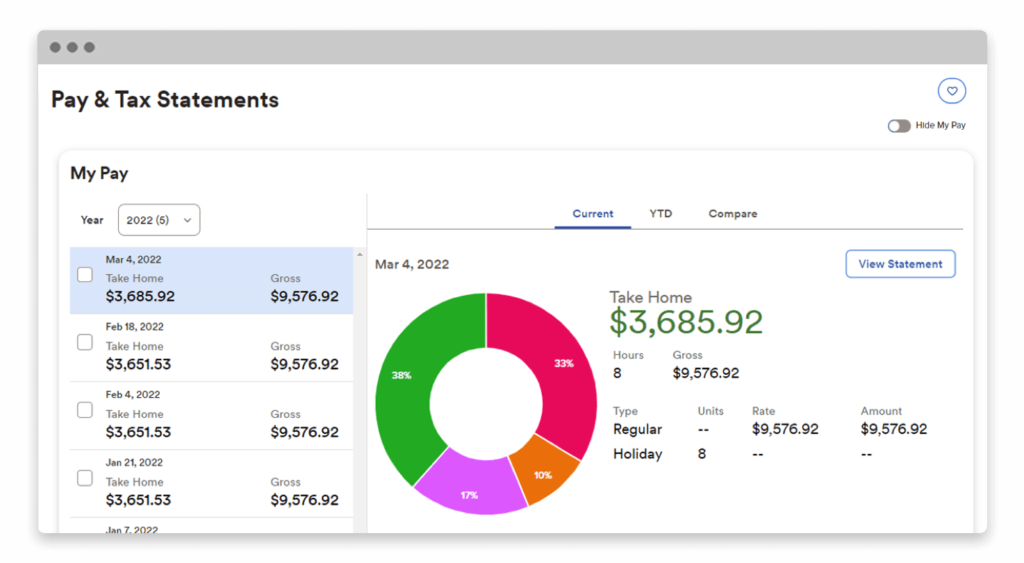
Comparison and Conclusion
In the comparison of Workday vs ADP Workforce Now for payroll management, both platforms offer robust solutions, but their approaches and strengths differ.
Workday excels with its integrated and real-time payroll system, providing seamless data flow and enhanced compliance features. Its global payroll capabilities make it a strong choice for multinational organizations. The real-time calculations and employee self-service options add to its appeal for modern, dynamic businesses.
ADP Workforce Now, on the other hand, offers a time-tested, comprehensive payroll management system with extensive tax compliance features and scalability. Its ability to handle payroll for businesses of all sizes, along with its reliable payroll processing and various payment methods, make it a solid choice for organizations seeking a flexible and reliable payroll solution.
Ultimately, choosing between Workday and ADP Workforce Now for payroll management will depend on your organization’s specific needs. If you require a modern, integrated system with real-time capabilities, Workday might be the better option. If you need a flexible, scalable solution with a strong focus on tax compliance and reliable payroll processing, ADP Workforce Now could be the right fit.
Time and Attendance Tracking
Effective time and attendance tracking is essential for managing workforce productivity and ensuring accurate payroll. Both Workday and ADP Workforce Now offer comprehensive solutions for time and attendance tracking, each with its unique features and strengths. Let’s explore how each platform approaches this critical function.

Workday Time and Attendance Tracking
Workday provides a modern, integrated approach to time and attendance tracking. Its system is designed to streamline time management processes, reduce errors, and enhance compliance.
Key Features of Workday Time and Attendance Tracking:
- Integrated Time Tracking: Workday’s time tracking is fully integrated with its core HR and payroll modules, ensuring seamless data flow and reducing administrative burden.
- Real-Time Data: The platform offers real-time visibility into employee hours, allowing managers to make informed decisions quickly.
- Flexible Scheduling: Workday supports flexible scheduling options, including shift swapping and automated scheduling based on employee availability and business needs.
- Mobile Access: Employees can clock in and out, request time off, and view their schedules from the Workday mobile app, enhancing convenience and accessibility.
- Compliance Management: Workday includes features to ensure compliance with labor laws and company policies, reducing the risk of violations and penalties.
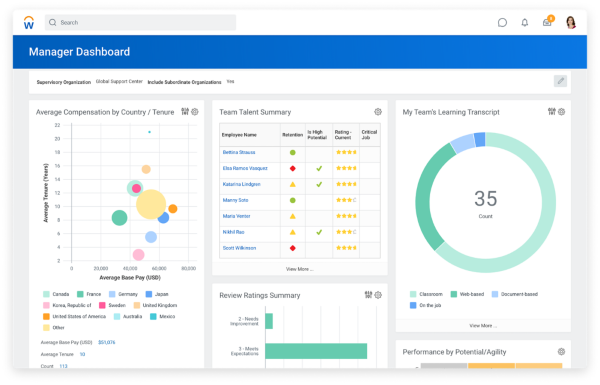
ADP Workforce Now Time and Attendance Tracking
ADP Workforce Now offers a robust and flexible time and attendance tracking system that caters to the needs of businesses of all sizes. Its solution is designed to improve accuracy, efficiency, and compliance.
Key Features of ADP Workforce Now Time and Attendance Tracking:
- Comprehensive Time Tracking: ADP provides various methods for time tracking, including biometric time clocks, web-based entry, and mobile apps, accommodating different business environments.
- Automated Attendance Management: The system automates attendance tracking, reducing manual errors and administrative workload.
- Flexible Reporting: ADP offers customizable reporting options, allowing managers to access detailed insights into employee attendance patterns and productivity.
- Leave Management: ADP’s integrated leave management features make it easy to track and approve time off requests, ensuring accurate accruals and compliance.
- Mobile Functionality: The ADP mobile app enables employees to clock in and out, view their schedules, and request time off, enhancing flexibility and accessibility.
Comparison and Conclusion
In the comparison of Workday vs ADP Workforce Now for time and attendance tracking, both platforms offer powerful tools, but they cater to different needs and preferences.
Workday excels with its integrated, real-time time tracking system that ensures seamless data flow between HR and payroll. Its flexible scheduling options and robust compliance management make it a great choice for organizations seeking a modern, streamlined solution. The mobile app further enhances user convenience by allowing employees to manage their time on the go.
ADP Workforce Now, on the other hand, offers a versatile and comprehensive time and attendance tracking system with multiple tracking methods and robust reporting capabilities. Its flexibility and scalability make it suitable for businesses of all sizes, and the integrated leave management and mobile functionality add to its appeal.
Ultimately, choosing between Workday and ADP Workforce Now for time and attendance tracking will depend on your organization’s specific needs. If you value an integrated, real-time system with strong compliance features, Workday may be the better choice. If you need a flexible, scalable solution with comprehensive tracking methods and reporting, ADP could be the right fit.
Benefits Administration
Benefits administration is a critical component of HR management, ensuring that employees have access to the benefits they need while maintaining compliance and efficiency. Both Workday and ADP Workforce Now offer robust benefits administration solutions, each with its unique features and strengths. Let’s explore how each platform handles benefits administration.

Workday Benefits Administration
Workday offers a comprehensive benefits administration module designed to simplify and automate the management of employee benefits. Its integrated approach ensures that benefits data is seamlessly connected with other HR functions.
Key Features of Workday Benefits Administration:
- Integrated Benefits Management: Workday’s benefits administration is fully integrated with its core HR, payroll, and time tracking modules, ensuring seamless data flow and reducing administrative burden.
- Employee Self-Service: Employees can easily enroll in benefits, make changes during open enrollment periods, and view their benefits information through a self-service portal.
- Automated Processes: Workday automates many benefits administration tasks, such as eligibility tracking and benefits reporting, reducing manual effort and increasing accuracy.
- Compliance Management: The platform includes features to help organizations stay compliant with benefits regulations, such as the Affordable Care Act (ACA) and other local laws.
- Flexible Plan Design: Workday supports a wide range of benefits plans, including health, dental, vision, retirement, and wellness programs, allowing organizations to offer competitive benefits packages.
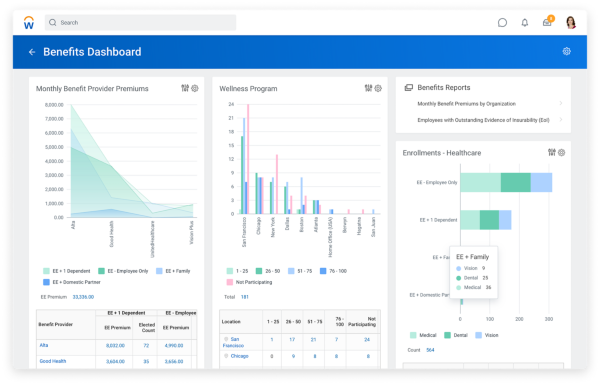
ADP Workforce Now Benefits Administration
ADP Workforce Now is known for its comprehensive and flexible benefits administration solutions, catering to the needs of businesses of all sizes. Its platform is designed to enhance efficiency, accuracy, and employee satisfaction.
Key Features of ADP Workforce Now Benefits Administration:
- Comprehensive Benefits Management: ADP offers a wide range of benefits management tools, from plan design and enrollment to compliance and reporting.
- Employee Self-Service: The ADP self-service portal allows employees to manage their benefits, enroll in new plans, and access benefits information easily.
- Automated Enrollment: ADP automates the benefits enrollment process, including open enrollment and life event changes, reducing administrative workload.
- Compliance Support: ADP’s benefits administration includes robust compliance support, helping organizations adhere to regulations such as ACA, COBRA, and HIPAA.
- Integration with Payroll: ADP seamlessly integrates benefits administration with its payroll system, ensuring accurate deductions and contributions.
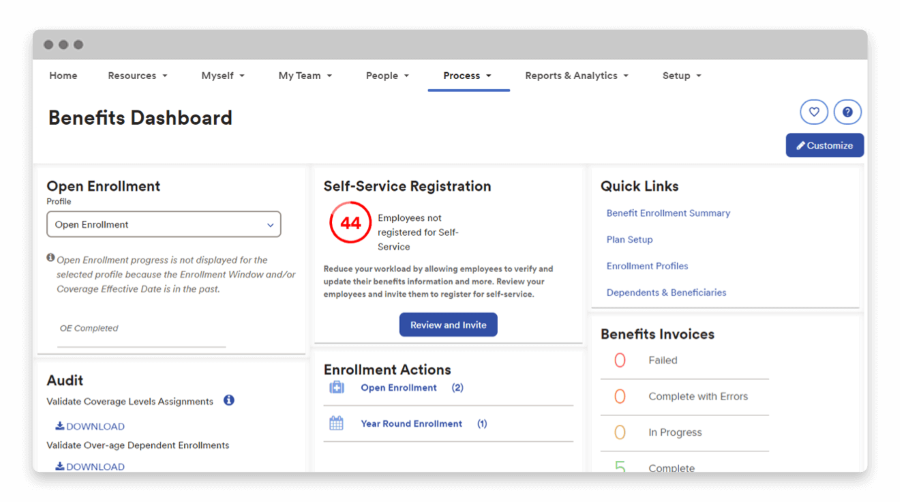
Comparison and Conclusion
In the debate of Workday vs ADP Workforce Now for benefits administration, both platforms offer powerful and efficient solutions, but they cater to different needs and preferences.
Workday excels with its integrated benefits management system that connects seamlessly with other HR functions. Its automated processes, compliance management features, and flexible plan design make it an ideal choice for organizations seeking a comprehensive and modern benefits administration solution. The employee self-service portal enhances user experience by allowing employees to manage their benefits easily.
ADP Workforce Now, on the other hand, offers a flexible and comprehensive benefits administration solution with robust compliance support and automated enrollment processes. Its integration with payroll ensures accurate benefits deductions and contributions, making it suitable for businesses of all sizes. The employee self-service portal adds to its appeal by providing easy access to benefits information and management.
Ultimately, choosing between Workday and ADP Workforce Now for benefits administration will depend on your organization’s specific needs. If you value an integrated, automated system with strong compliance features, Workday may be the better choice. If you need a flexible, scalable solution with comprehensive compliance support and integration with payroll, ADP Workforce Now could be the right fit.
Performance Management
Performance management is a key aspect of HR that helps organizations align employee goals with business objectives, track performance, and foster employee development. Both Workday and ADP Workforce Now offer robust performance management solutions, each with its unique features and strengths. Let’s explore how each platform handles performance management.

Workday Performance Management
Workday provides a comprehensive performance management system designed to enhance employee performance and development. Its integrated approach ensures that performance data is seamlessly connected with other HR functions.
Key Features of Workday Performance Management:
- Goal Setting and Tracking: Workday allows managers and employees to set, track, and update performance goals, ensuring alignment with organizational objectives.
- Continuous Feedback: The platform supports continuous feedback and check-ins, promoting regular communication between managers and employees.
- Performance Reviews: Workday offers flexible performance review templates and workflows, making it easy to conduct annual or quarterly reviews.
- Development Plans: Employees can create and manage development plans within the system, aligning their personal growth with company goals.
- Analytics and Reporting: Workday provides robust analytics and reporting tools, allowing HR to track performance trends and identify areas for improvement.
ADP Workforce Now Performance Management
ADP Workforce Now offers a flexible and scalable performance management solution that caters to businesses of all sizes. Its platform is designed to enhance performance tracking, feedback, and employee development.
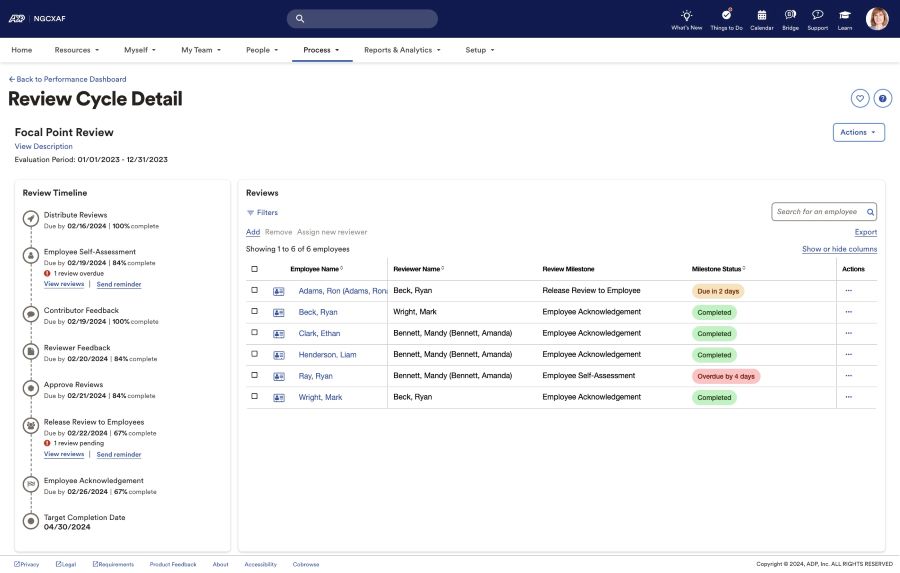
Key Features of ADP Workforce Now Performance Management:
- Goal Management: ADP’s goal management features allow for the setting, tracking, and updating of employee performance goals, ensuring they align with business objectives.
- Feedback and Check-Ins: The platform supports ongoing feedback and regular check-ins, fostering continuous performance improvement.
- Customizable Reviews: ADP provides customizable performance review templates and processes, making it easy to tailor reviews to the organization’s needs.
- Employee Development: ADP includes tools for creating and managing employee development plans, helping to support career growth and skill development.
- Performance Analytics: ADP offers comprehensive performance analytics and reporting, providing insights into employee performance and identifying trends.
Comparison and Conclusion
In the debate of Workday vs ADP Workforce Now for performance management, both platforms offer powerful and efficient solutions, but they cater to different needs and preferences.
Workday excels with its integrated performance management system that connects seamlessly with other HR functions. Its focus on continuous feedback, goal tracking, and development plans makes it an ideal choice for organizations seeking a comprehensive and modern performance management solution. The robust analytics and reporting tools enhance HR’s ability to track performance trends and make data-driven decisions.
ADP Workforce Now, on the other hand, offers a flexible and scalable performance management solution with strong goal management and customizable review processes. Its support for continuous feedback and employee development makes it suitable for businesses of all sizes. The comprehensive performance analytics provide valuable insights, helping organizations improve overall performance.
Ultimately, choosing between Workday and ADP Workforce Now for performance management will depend on your organization’s specific needs. If you value an integrated, modern system with a focus on continuous feedback and development, Workday may be the better choice. If you need a flexible, scalable solution with customizable reviews and robust analytics, ADP could be the right fit.
Talent Management and Recruiting
Talent management and recruiting are critical functions for any organization aiming to attract, develop, and retain top talent. Both Workday and ADP Workforce Now offer comprehensive talent management and recruiting solutions, each with its unique features and strengths. Let’s explore how each platform handles these essential HR tasks.

Workday Talent Management and Recruiting
Workday offers an integrated talent management and recruiting system designed to streamline the entire talent lifecycle from hiring to development and retention. Its platform emphasizes user experience and seamless integration with other HR functions.
Key Features of Workday Talent Management and Recruiting:
- Recruiting: Workday provides a unified recruiting solution that covers job posting, candidate management, and hiring workflows. The platform integrates with popular job boards and social media sites to enhance reach.
- Talent Acquisition: The system includes tools for managing the candidate pipeline, conducting interviews, and making offers, ensuring a smooth hiring process.
- Onboarding: Workday’s onboarding features help new hires integrate quickly with automated workflows and access to necessary resources.
- Performance Management: Integrated performance management tools allow for continuous feedback and goal setting, aligning employee performance with company objectives.
- Succession Planning: Workday supports succession planning by identifying and developing potential future leaders within the organization.
- Learning and Development: The platform includes robust learning management features, supporting employee training and development initiatives.
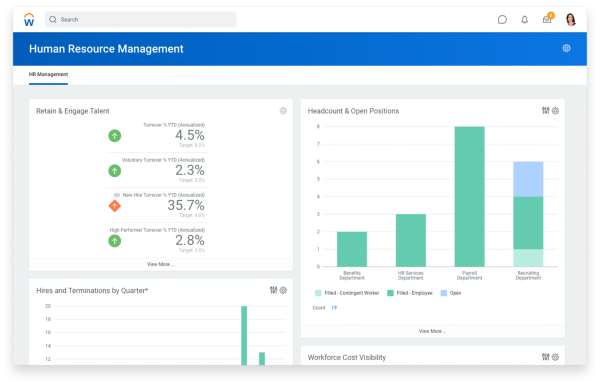
ADP Workforce Now Talent Management and Recruiting
ADP Workforce Now provides a comprehensive talent management and recruiting solution that caters to businesses of all sizes. Its platform is designed to improve the efficiency of hiring and employee development processes.
Key Features of ADP Workforce Now Talent Management and Recruiting:
- Recruiting: ADP offers a complete recruiting solution, including job posting, applicant tracking, and candidate management. The system integrates with job boards and social media platforms to enhance recruitment efforts.
- Talent Acquisition: ADP’s talent acquisition tools streamline the hiring process, from applicant tracking to interview scheduling and offer management.
- Onboarding: The platform features automated onboarding processes, helping new hires transition smoothly into their roles.
- Performance Management: ADP includes tools for setting performance goals, conducting reviews, and providing continuous feedback, ensuring employees are aligned with business objectives.
- Succession Planning: The system supports succession planning by identifying key talent and preparing them for future leadership roles.
- Learning and Development: ADP’s learning management features enable organizations to deliver training and development programs effectively.
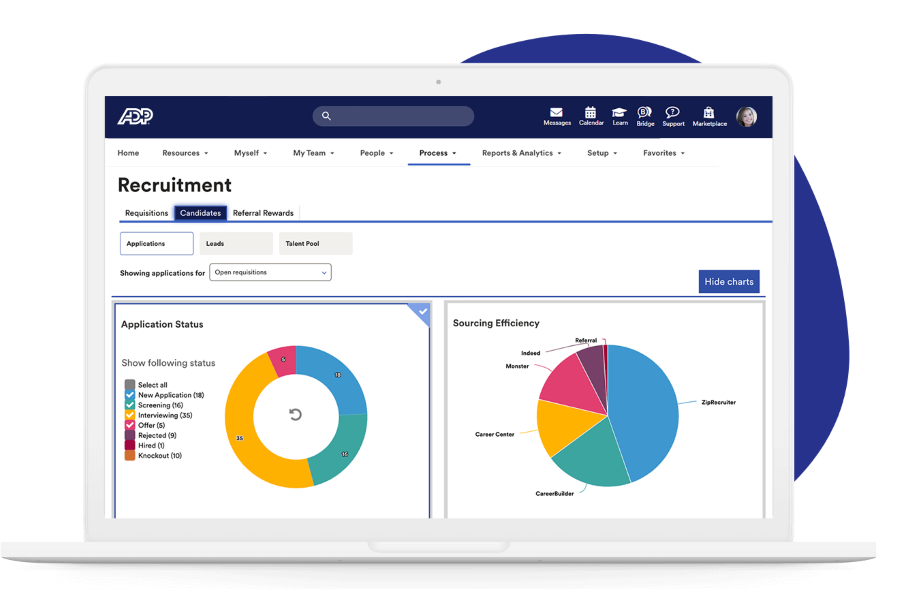
Comparison and Conclusion
In the debate of Workday vs ADP Workforce Now for talent management and recruiting, both platforms offer robust and efficient solutions, but they cater to different needs and preferences.
Workday excels with its integrated approach that connects talent management seamlessly with other HR functions. Its unified recruiting solution, comprehensive onboarding, and strong focus on performance management and succession planning make it an ideal choice for organizations seeking a holistic and modern talent management system. The emphasis on learning and development further enhances employee growth and retention.
ADP Workforce Now, on the other hand, provides a flexible and comprehensive talent management and recruiting solution that suits businesses of all sizes. Its robust recruiting tools, automated onboarding processes, and support for performance management and succession planning make it a strong contender. The learning management features ensure that employees receive the training they need to succeed.
Ultimately, choosing between Workday and ADP Workforce Now for talent management and recruiting will depend on your organization’s specific needs. If you value an integrated, modern system with a focus on holistic talent management, Workday may be the better choice. If you need a flexible, scalable solution with comprehensive recruiting and development tools, ADP Workforce Now could be the right fit.
Learning and Development
Learning and development are essential components for fostering employee growth, enhancing skills, and driving organizational success. Both Workday and ADP Workforce Now offer comprehensive learning and development solutions, each with its unique features and strengths. Let’s explore how each platform handles these critical functions.

Workday Learning and Development
Workday provides a robust learning and development system designed to support continuous employee education and skill enhancement. Its platform emphasizes seamless integration with other HR functions and user-friendly features.
Key Features of Workday Learning and Development:
- Integrated Learning Management: Workday’s learning management system (LMS) is fully integrated with its core HR modules, ensuring seamless data flow and reducing administrative burden.
- Personalized Learning Paths: The platform allows organizations to create personalized learning paths tailored to individual employee needs and career goals.
- Content Delivery: Workday supports various content formats, including videos, articles, and interactive modules, providing a rich and engaging learning experience.
- Mobile Learning: Employees can access learning materials on the go through the Workday mobile app, enhancing flexibility and convenience.
- Analytics and Reporting: Workday offers robust analytics and reporting tools to track learning progress, measure effectiveness, and identify skill gaps.
- Compliance Training: The platform includes features to manage compliance training, ensuring that employees meet regulatory and organizational requirements.
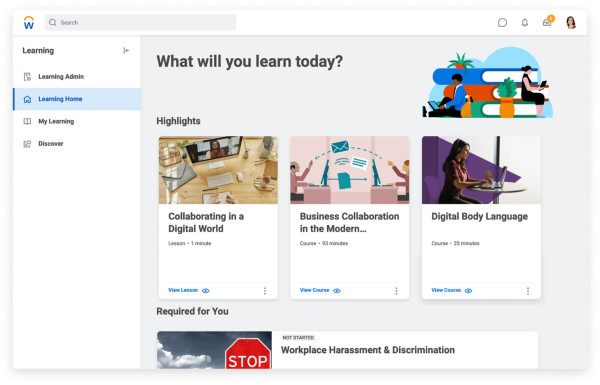
ADP Workforce Now Learning and Development
ADP Workforce Now provides a comprehensive learning and development solution that caters to the needs of businesses of all sizes. Its platform is designed to enhance employee training and development processes, improving overall performance and engagement.
Key Features of ADP Workforce Now Learning and Development:
- Comprehensive LMS: ADP’s learning management system supports a wide range of training programs, from onboarding to ongoing professional development.
- Customizable Learning Paths: The platform allows for the creation of customized learning paths, aligning training with individual and organizational goals.
- Diverse Content Formats: ADP supports multiple content formats, including e-learning modules, webinars, and in-person training, providing a flexible learning environment.
- Mobile Access: Employees can access learning materials anytime, anywhere through the ADP mobile app, making learning more accessible.
- Performance Tracking: ADP offers tools to track employee progress, assess training effectiveness, and identify areas for improvement.
- Compliance Management: The platform includes features to manage and track compliance training, ensuring that employees stay up-to-date with necessary certifications and regulations.
Comparison and Conclusion
In the debate of Workday vs ADP Workforce Now for learning and development, both platforms offer powerful and efficient solutions, but they cater to different needs and preferences.
Workday excels with its integrated learning management system that connects seamlessly with other HR functions. Its focus on personalized learning paths, diverse content delivery, and robust analytics makes it an ideal choice for organizations seeking a comprehensive and modern learning and development solution. The mobile learning capabilities further enhance flexibility and employee engagement.
ADP Workforce Now, on the other hand, provides a flexible and comprehensive learning and development solution that suits businesses of all sizes. Its customizable learning paths, diverse content formats, and performance tracking tools make it a strong contender. The mobile access and compliance management features ensure that employees receive the necessary training and stay compliant with regulations.
Ultimately, choosing between Workday and ADP Workforce Now for learning and development will depend on your organization’s specific needs. If you value an integrated, modern system with a focus on personalized learning and robust analytics, Workday may be the better choice. If you need a flexible, scalable solution with diverse content formats and strong compliance management, ADP Workforce Now could be the right fit.
Reporting and Analytics
Effective reporting and analytics are essential for making informed decisions and optimizing HR processes. Both Workday and ADP Workforce Now offer comprehensive reporting and analytics solutions, each with its unique features and strengths. Let’s explore how each platform handles these critical functions.

Workday Reporting and Analytics
Workday provides a powerful reporting and analytics system designed to deliver real-time insights and support data-driven decision-making. Its platform emphasizes seamless integration and user-friendly features.
Key Features of Workday Reporting and Analytics:
- Real-Time Analytics: Workday offers real-time analytics, providing immediate access to up-to-date data across various HR functions.
- Customizable Reports: The platform allows users to create and customize reports based on specific organizational needs, ensuring relevant insights.
- Dashboards: Workday’s interactive dashboards provide a visual representation of key metrics, making it easy to monitor HR performance at a glance.
- Predictive Analytics: The system includes predictive analytics capabilities, helping organizations forecast trends and make proactive decisions.
- Integration: Workday’s analytics are integrated with its core HR modules, ensuring seamless data flow and reducing the need for manual data entry.
- Data Security: The platform includes robust security features to protect sensitive data, ensuring compliance with data protection regulations.
ADP Workforce Now Reporting and Analytics
ADP Workforce Now offers a comprehensive reporting and analytics solution designed to enhance HR management and support strategic planning. Its platform is built to provide detailed insights and improve decision-making processes.
Key Features of ADP Workforce Now Reporting and Analytics:
- Extensive Reporting: ADP provides a wide range of pre-built and customizable reports, covering various HR metrics such as payroll, attendance, and benefits.
- Data Visualization: The platform includes advanced data visualization tools, enabling users to create charts, graphs, and dashboards for easier data interpretation.
- Real-Time Data: ADP offers real-time data access, ensuring that users have the most current information for decision-making.
- Benchmarking: The system includes benchmarking tools, allowing organizations to compare their performance against industry standards.
- Integration: ADP’s reporting and analytics seamlessly integrate with its other HR modules, ensuring accurate and consistent data across the platform.
- Security and Compliance: ADP ensures data security and compliance with robust security measures and adherence to data protection regulations.
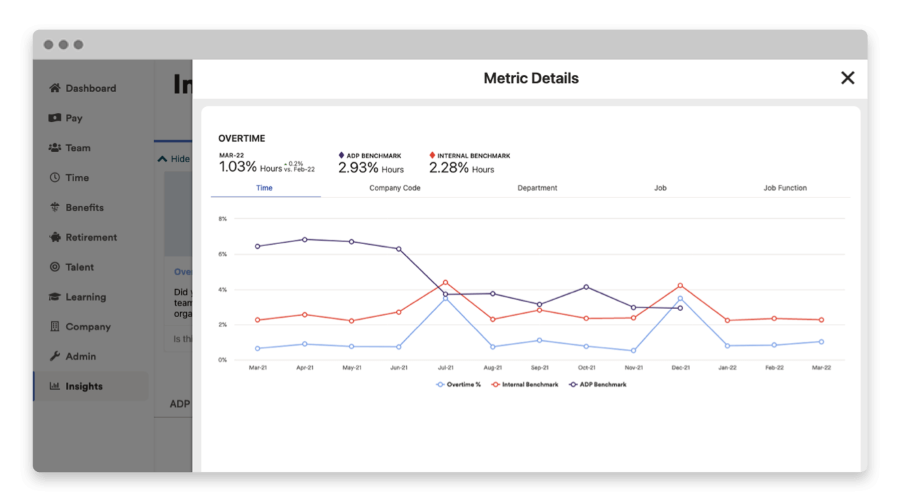
Comparison and Conclusion
In the debate of Workday vs ADP Workforce Now for reporting and analytics, both platforms offer powerful and efficient solutions, but they cater to different needs and preferences.
Workday excels with its integrated, real-time analytics and customizable reporting capabilities. Its interactive dashboards, predictive analytics, and robust security features make it an ideal choice for organizations seeking a comprehensive and modern reporting and analytics solution. The seamless integration with other HR functions further enhances data accuracy and accessibility.
ADP Workforce Now, on the other hand, provides a flexible and extensive reporting and analytics solution that suits businesses of all sizes. Its advanced data visualization tools, benchmarking capabilities, and real-time data access make it a strong contender. The integration with other HR modules and focus on security and compliance ensure reliable and secure data management.
Ultimately, choosing between Workday and ADP Workforce Now for reporting and analytics will depend on your organization’s specific needs. If you value an integrated, modern system with real-time analytics and predictive capabilities, Workday may be the better choice. If you need a flexible, scalable solution with extensive reporting options and benchmarking tools, ADP Workforce Now could be the right fit.
Compliance and Security
Compliance and security are paramount for any organization managing sensitive employee data and adhering to regulatory requirements. Both Workday and ADP Workforce Now offer robust compliance and security solutions, each with its unique features and strengths. Let’s explore how each platform handles these critical functions.

Workday Compliance and Security
Workday provides a comprehensive compliance and security framework designed to protect sensitive data and ensure adherence to regulatory standards. Its platform emphasizes seamless integration and user-friendly features to support compliance and security management.
Key Features of Workday Compliance and Security:
- Regulatory Compliance: Workday supports compliance with various regulatory standards, including GDPR, HIPAA, and SOC 1 and 2. The platform includes tools to help organizations stay up-to-date with changing regulations.
- Data Security: Workday uses advanced security measures, including encryption, multi-factor authentication, and regular security audits, to protect sensitive data.
- Audit Trails: The system provides detailed audit trails, ensuring transparency and accountability in data management processes.
- Access Controls: Workday offers robust access control features, allowing organizations to define and manage user permissions based on roles and responsibilities.
- Incident Response: Workday has a dedicated incident response team to quickly address and resolve any security issues, ensuring minimal disruption to operations.
- Compliance Reporting: The platform includes comprehensive compliance reporting tools, making it easy for organizations to generate reports and demonstrate compliance with regulatory requirements.
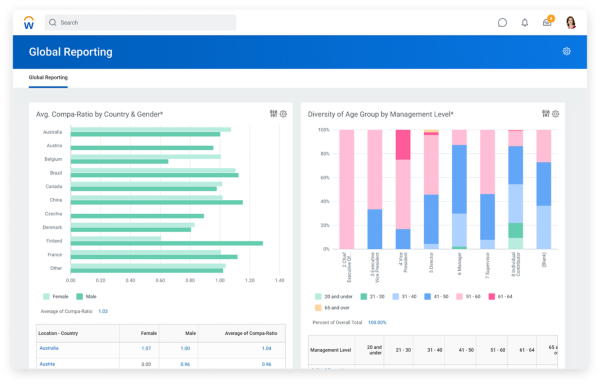
ADP Workforce Now Compliance and Security
ADP Workforce Now is known for its extensive compliance and security solutions, catering to the needs of businesses of all sizes. Its platform is designed to enhance data protection and support regulatory compliance effectively.
Key Features of ADP Workforce Now Compliance and Security:
- Regulatory Support: ADP provides support for various regulatory standards, including ACA, GDPR, and SOC 1 and 2. The system is updated regularly to reflect changes in regulations, helping organizations maintain compliance.
- Data Protection: ADP employs advanced data protection measures, such as encryption, secure data centers, and multi-factor authentication, to safeguard sensitive information.
- Audit and Compliance: ADP offers comprehensive audit and compliance tools, providing detailed audit trails and ensuring transparency in data management.
- Access Management: The platform includes robust access management features, allowing organizations to control and monitor user access based on their roles.
- Security Monitoring: ADP has a dedicated security team that continuously monitors the system for potential threats and responds to incidents promptly.
- Compliance Reporting: ADP provides extensive compliance reporting capabilities, enabling organizations to generate necessary reports and maintain regulatory compliance.
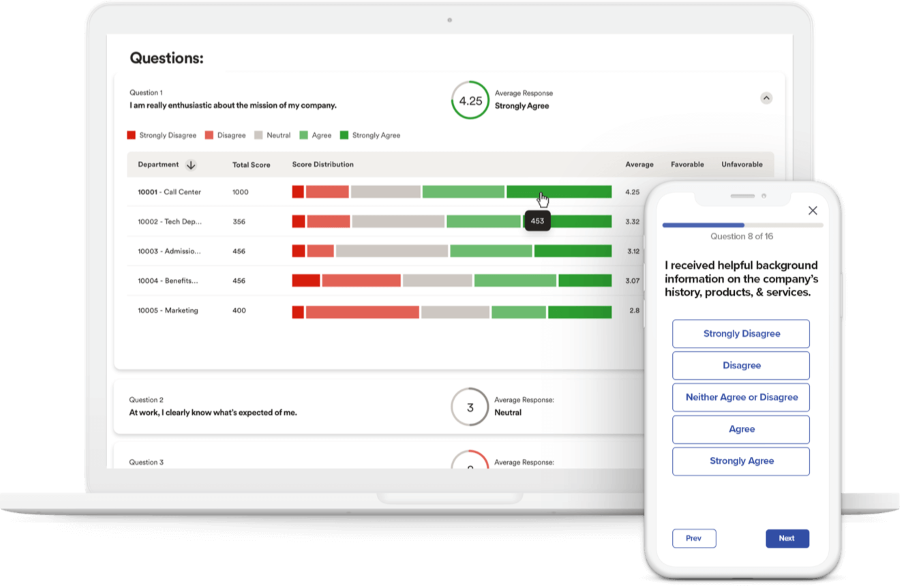
Comparison and Conclusion
In the debate of Workday vs ADP Workforce Now for compliance and security, both platforms offer powerful and efficient solutions, but they cater to different needs and preferences.
Workday excels with its integrated compliance and security framework, providing advanced security measures, robust access controls, and comprehensive compliance reporting tools. Its focus on regulatory compliance and incident response ensures that organizations can manage sensitive data securely and stay compliant with regulations.
ADP Workforce Now, on the other hand, offers a flexible and extensive compliance and security solution that suits businesses of all sizes. Its advanced data protection measures, continuous security monitoring, and comprehensive audit tools make it a strong contender. The platform’s regulatory support and compliance reporting capabilities ensure reliable and secure data management.
Ultimately, choosing between Workday and ADP Workforce Now for compliance and security will depend on your organization’s specific needs. If you value an integrated, modern system with advanced security and compliance features, Workday may be the better choice. If you need a flexible, scalable solution with robust data protection and regulatory support, ADP Workforce Now could be the right fit.
Integration and Compatibility
Integration and compatibility are vital for ensuring that your HR software works seamlessly with other systems and processes within your organization. Both Workday and ADP Workforce Now offer robust integration capabilities, each with its unique features and strengths. Let’s explore how each platform handles integration and compatibility.

Workday Integration and Compatibility
Workday provides a highly flexible integration framework designed to connect with a wide range of systems and applications. Its platform emphasizes ease of integration and compatibility with other business tools.
Key Features of Workday Integration and Compatibility:
- Pre-Built Integrations: Workday offers a variety of pre-built integrations with popular business applications, including Salesforce, Microsoft Office 365, and Slack, ensuring seamless data flow between systems.
- API and Web Services: The platform provides robust API and web services capabilities, allowing organizations to build custom integrations tailored to their specific needs.
- Workday Integration Cloud: Workday’s Integration Cloud is a powerful tool that enables users to create, manage, and deploy integrations without the need for extensive coding knowledge.
- Data Synchronization: Workday ensures real-time data synchronization across integrated systems, reducing the risk of data inconsistencies and improving operational efficiency.
- Third-Party Integrations: The platform supports integrations with numerous third-party applications, enhancing its flexibility and compatibility with various business tools.
- Seamless Upgrades: Workday’s integration framework is designed to handle system upgrades seamlessly, ensuring that integrations remain intact and functional.
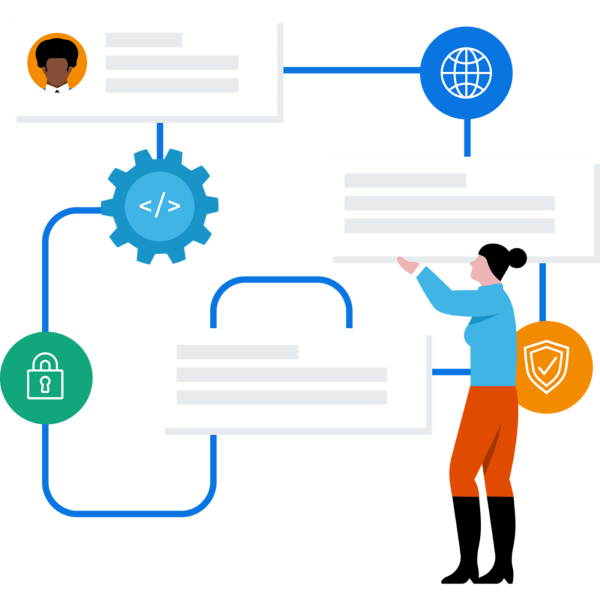
ADP Workforce Now Integration and Compatibility
ADP Workforce Now offers a comprehensive integration and compatibility solution that caters to the needs of businesses of all sizes. Its platform is designed to enhance connectivity with other systems and improve data flow across the organization.
Key Features of ADP Workforce Now Integration and Compatibility:
- ADP Marketplace: ADP’s Marketplace provides a wide range of pre-built integrations with popular business applications, including QuickBooks, Salesforce, and Google Workspace, facilitating easy connectivity.
- API Access: ADP offers extensive API access, allowing organizations to develop custom integrations and connect with other business systems.
- Data Connector: The ADP Data Connector is a powerful tool that enables seamless data exchange between ADP and other business applications, ensuring accurate and up-to-date information.
- Integration Services: ADP provides professional integration services to help organizations implement and manage integrations effectively, reducing the complexity and ensuring smooth operation.
- Third-Party Applications: ADP supports integrations with numerous third-party applications, enhancing its compatibility and flexibility.
- Upgrade Management: The platform is designed to handle system upgrades without disrupting existing integrations, ensuring continuous and reliable operation.
Comparison and Conclusion
In the debate of Workday vs ADP Workforce Now for integration and compatibility, both platforms offer powerful and efficient solutions, but they cater to different needs and preferences.
Workday excels with its flexible integration framework, robust API capabilities, and comprehensive Integration Cloud. Its pre-built integrations, real-time data synchronization, and seamless upgrade management make it an ideal choice for organizations seeking a modern and adaptable integration solution.
ADP Workforce Now, on the other hand, provides a versatile and extensive integration solution that suits businesses of all sizes. Its ADP Marketplace, extensive API access, and professional integration services make it a strong contender. The platform’s focus on seamless data exchange and third-party application support ensures reliable and flexible integration.
Ultimately, choosing between Workday and ADP Workforce Now for integration and compatibility will depend on your organization’s specific needs. If you value a highly flexible, modern integration framework with robust API capabilities, Workday may be the better choice. If you need a versatile, scalable solution with extensive pre-built integrations and professional services, ADP Workforce Now could be the right fit.
Customer Support and Service
Customer support and service are critical components when choosing an HCM solution. Effective support ensures that any issues are quickly resolved, and users can fully leverage the platform’s capabilities. Both Workday and ADP Workforce Now offer extensive customer support and service options, each with its unique features and strengths. Let’s explore how each platform handles customer support and service.

Workday Customer Support and Service
Workday provides comprehensive customer support and service designed to assist users in maximizing the platform’s benefits. Its support structure emphasizes responsiveness and a wide range of support options.
Key Features of Workday Customer Support and Service:
- 24/7 Support: Workday offers round-the-clock support to address any issues or questions, ensuring that help is available whenever it is needed.
- Dedicated Account Managers: Each customer is assigned a dedicated account manager who serves as a primary point of contact, providing personalized support and guidance.
- Online Community: Workday has an extensive online community where users can share insights, ask questions, and access a wealth of resources.
- Comprehensive Documentation: The platform provides detailed documentation, including user guides, FAQs, and best practice guides, helping users find answers quickly.
- Training Programs: Workday offers various training programs, including online courses, webinars, and in-person training sessions, to help users effectively utilize the platform.
- Customer Success Program: Workday’s Customer Success Program focuses on proactive engagement, ensuring customers achieve their desired outcomes with the platform.
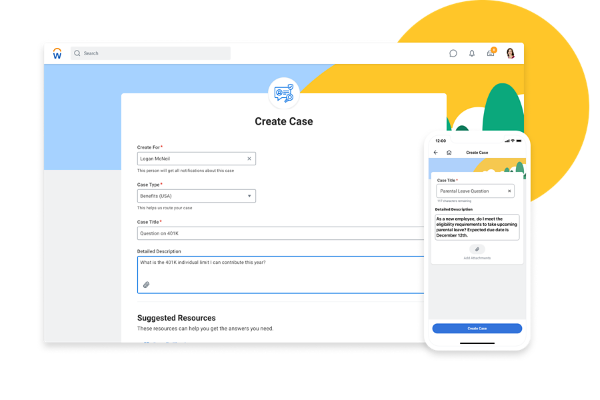
ADP Workforce Now Customer Support and Service
ADP Workforce Now is renowned for its robust customer support and service, catering to businesses of all sizes. Its support structure is designed to ensure users receive timely and effective assistance.
Key Features of ADP Workforce Now Customer Support and Service:
- 24/7 Customer Support: ADP provides 24/7 customer support through multiple channels, including phone, email, and live chat, ensuring help is always available.
- Dedicated Support Teams: ADP assigns dedicated support teams to larger accounts, providing tailored assistance and expertise.
- Knowledge Base: The platform offers a comprehensive knowledge base with articles, guides, and FAQs to help users troubleshoot issues independently.
- Training and Certification: ADP provides extensive training and certification programs, ensuring users are well-equipped to utilize the platform effectively.
- Webinars and Workshops: ADP regularly hosts webinars and workshops to keep users informed about new features and best practices.
- Customer Feedback Loop: ADP actively solicits customer feedback to continuously improve its services and address user needs more effectively.
Comparison and Conclusion
In the debate of Workday vs ADP Workforce Now for customer support and service, both platforms offer robust and efficient solutions, but they cater to different needs and preferences.
Workday excels with its comprehensive and proactive customer support structure. The 24/7 support, dedicated account managers, and extensive online community ensure that users have access to the help and resources they need. The focus on training and customer success programs further enhances the user experience, making it an ideal choice for organizations seeking personalized and responsive support.
ADP Workforce Now, on the other hand, provides a versatile and extensive support solution that suits businesses of all sizes. The 24/7 customer support, dedicated support teams, and comprehensive knowledge base ensure reliable and accessible assistance. The platform’s emphasis on training, certification, and customer feedback ensures that users are well-supported and continuously informed.
Ultimately, choosing between Workday and ADP Workforce Now for customer support and service will depend on your organization’s specific needs. If you value a proactive, personalized support structure with extensive training resources, Workday may be the better choice. If you need a versatile, scalable support solution with comprehensive resources and continuous feedback, ADP Workforce Now could be the right fit.
Pricing and Cost-effectiveness
Pricing and cost-effectiveness are critical considerations when selecting an HCM solution. Both Workday and ADP Workforce Now offer different pricing structures and value propositions, catering to various business sizes and needs. Let’s explore how each platform approaches pricing and cost-effectiveness.

Workday Pricing and Cost-effectiveness
Workday provides a flexible pricing model designed to accommodate the specific needs of different organizations. Its pricing is generally subscription-based, with costs varying depending on the number of users and the specific modules chosen.
Key Features of Workday Pricing and Cost-effectiveness:
- Subscription-Based Pricing: Workday offers a subscription-based pricing model, where costs are typically charged on a per-employee-per-month basis.
- Modular Pricing: Customers can choose specific modules they need, such as core HR, payroll, and talent management, allowing for a tailored pricing approach.
- Scalability: Workday’s pricing structure scales with the size of the organization, making it suitable for medium to large enterprises.
- Implementation Costs: Initial implementation costs can be significant, as Workday requires a thorough setup process tailored to the organization’s needs.
- Total Cost of Ownership: While the upfront costs can be high, Workday’s comprehensive features and integration capabilities can lead to long-term cost savings through improved efficiency and reduced manual processes.
For more information about pricing, please visit Workday’s website.
ADP Workforce Now Pricing and Cost-effectiveness
ADP Workforce Now offers a variety of pricing plans designed to meet the needs of businesses of all sizes. Its pricing structure is also subscription-based, with options that can be customized based on the specific services and modules required.
Key Features of ADP Workforce Now Pricing and Cost-effectiveness:
- Flexible Pricing Plans: ADP provides flexible pricing plans, including per-employee-per-month charges, catering to small, medium, and large businesses.
- Bundled Services: ADP offers bundled service packages that can include payroll, benefits administration, and talent management, providing cost savings through comprehensive solutions.
- Scalability: ADP’s pricing is scalable, making it accessible for businesses at different stages of growth, from startups to large enterprises.
- Implementation and Support Costs: ADP’s implementation costs are generally lower compared to Workday, and the platform offers extensive support to ensure smooth onboarding.
- Cost Efficiency: ADP’s comprehensive service offerings and competitive pricing make it a cost-effective solution for businesses looking to streamline their HR processes without significant upfront investments.
For more information about pricing, please visit ADP Workforce Now’s website.
Comparison and Conclusion
In the debate of Workday vs ADP Workforce Now for pricing and cost-effectiveness, both platforms offer flexible and scalable solutions, but they cater to different needs and financial considerations.
Workday excels with its modular pricing approach, allowing organizations to tailor their subscriptions based on specific needs. While the initial implementation costs can be high, the platform’s comprehensive features and integration capabilities can result in long-term cost savings and improved operational efficiency. Workday is ideal for medium to large enterprises looking for a robust, all-in-one HCM solution.
ADP Workforce Now, on the other hand, provides a more flexible and accessible pricing structure suitable for businesses of all sizes. Its bundled service packages and lower implementation costs make it a cost-effective option for organizations seeking comprehensive HR solutions without significant upfront investments. ADP is ideal for small to large enterprises that require scalable and flexible pricing options.
Ultimately, choosing between Workday and ADP Workforce Now for pricing and cost-effectiveness will depend on your organization’s specific needs and budget. If you value a customizable, all-encompassing solution with potential long-term cost savings, Workday may be the better choice. If you need a flexible, cost-effective solution with comprehensive service offerings, ADP Workforce Now could be the right fit.
User Reviews and Testimonials
User reviews and testimonials provide valuable insights into the real-world performance and user satisfaction of HCM solutions. Both Workday and ADP Workforce Now have garnered numerous reviews from businesses of various sizes, highlighting their strengths and areas for improvement. Let’s explore what users have to say about these two platforms.

Workday User Reviews and Testimonials
Workday is praised for its comprehensive features, user-friendly interface, and robust integration capabilities. Many users appreciate the platform’s modern design and the ability to customize dashboards and workflows.
Key Points from Workday User Reviews:
- Ease of Use: Users frequently highlight Workday’s intuitive interface and ease of navigation. The modern design and customizable dashboards are often mentioned as significant advantages.
- Comprehensive Features: Many reviews commend Workday for its extensive range of features, including payroll, talent management, and performance tracking. Users appreciate having all HR functions integrated into a single platform.
- Integration: Workday’s seamless integration with other business tools is a recurring positive point. Users find the platform’s ability to connect with various applications and systems enhances their overall HR processes.
- Support and Training: Workday’s customer support and training programs receive positive feedback. Users value the availability of online resources, tutorials, and dedicated support teams.
- Scalability: Larger organizations particularly appreciate Workday’s scalability, noting that the platform grows with their needs and supports complex HR requirements effectively.
Testimonials:
- HR Manager at a Fortune 500 Company: “Workday has transformed how we manage our HR processes. The integration across different functions and the real-time data access have significantly improved our efficiency.”
- IT Director at a Mid-sized Business: “The seamless integration with other business tools and the customizable workflows make Workday an invaluable asset for our organization. The support team is always responsive and helpful.”
ADP Workforce Now User Reviews and Testimonials
ADP Workforce Now is known for its reliable payroll services, extensive customer support, and flexible pricing plans. Users often highlight the platform’s robust compliance features and the ease of managing payroll and benefits.
Key Points from ADP Workforce Now User Reviews:
- Payroll Expertise: ADP’s payroll services are frequently praised for their accuracy and reliability. Users find the payroll processing straightforward and efficient.
- Customer Support: ADP receives high marks for its customer support. Users appreciate the 24/7 availability and the expertise of the support teams.
- Compliance: Many reviews highlight ADP’s strong compliance features. Users feel confident that the platform helps them stay compliant with various regulations and standards.
- User-Friendly: Despite having a traditional interface, users find ADP easy to navigate and use. The platform’s comprehensive help resources and training programs are also well-regarded.
- Flexibility and Scalability: ADP’s flexible pricing and scalable solutions are mentioned positively by businesses of all sizes. Users appreciate that ADP can grow with their business needs.
Testimonials:
- Payroll Specialist at a Small Business: “ADP’s payroll services are top-notch. The system is easy to use, and the customer support is always there when we need help.”
- HR Director at a Large Enterprise: “ADP’s compliance features give us peace of mind. The ability to manage payroll and benefits in one place has streamlined our HR processes significantly.”
Comparison and Conclusion
In the debate of Workday vs ADP Workforce Now for user reviews and testimonials, both platforms receive high marks from users, but they cater to different needs and preferences.
Workday excels with its comprehensive features, modern interface, and robust integration capabilities. Users appreciate its ease of use, scalability, and the extensive support and training resources. Larger organizations and those looking for a highly integrated solution often favor Workday.
ADP Workforce Now, on the other hand, is praised for its reliable payroll services, strong compliance features, and excellent customer support. Users find the platform user-friendly and appreciate its flexible pricing and scalability. Small to large enterprises looking for dependable payroll and HR management solutions often prefer ADP.
Ultimately, choosing between Workday and ADP Workforce Now for user reviews and testimonials will depend on your organization’s specific needs and preferences. If you value a modern, integrated solution with extensive features and support, Workday may be the better choice. If you need a reliable, flexible, and user-friendly payroll and HR management system, ADP Workforce Now could be the right fit.
Conclusion
In the comparison of Workday vs ADP Workforce Now , it’s clear that both HR platforms offer valuable features and capabilities tailored to different organizational needs. The choice between these two systems ultimately depends on the specific requirements, size, and complexity of your business.
Workday stands out for its comprehensive features, modern interface, and strong integration capabilities, making it an ideal choice for medium to large-sized businesses. Its intuitive design and seamless integration across HR functions help streamline processes, enhance efficiency, and improve overall user satisfaction. Workday’s strengths lie in its advanced analytics, real-time data access, and robust support and training resources, making it a practical solution for organizations seeking a sophisticated and holistic HR management system.
ADP Workforce Now, on the other hand, is designed to meet the needs of businesses of all sizes with its reliable payroll services, flexible pricing plans, and extensive customer support. Its comprehensive feature set, strong compliance tools, and scalability provide a robust solution capable of handling diverse HR tasks efficiently. ADP Workforce Now excels in offering user-friendly payroll management, detailed reporting, and a high degree of customization, making it a preferred choice for organizations seeking a dependable and cost-effective HR platform.
In summary, the decision between Workday and ADP Workforce Now should be guided by your organization’s specific HR needs, budget, and long-term growth plans. Workday is well-suited for larger businesses looking for an integrated, feature-rich HR solution with advanced analytics and strong support, while ADP Workforce Now is ideal for businesses of all sizes requiring a reliable, scalable platform for payroll and HR management with excellent customer service. By carefully evaluating the unique features, strengths, and user feedback of each system, you can choose the HR platform that best aligns with your organizational goals and ensures a positive impact on your HR processes.
![]()
![]() Read our full Workday review
Read our full Workday review
![]()
![]() Read our full ADP Workforce Now review
Read our full ADP Workforce Now review

